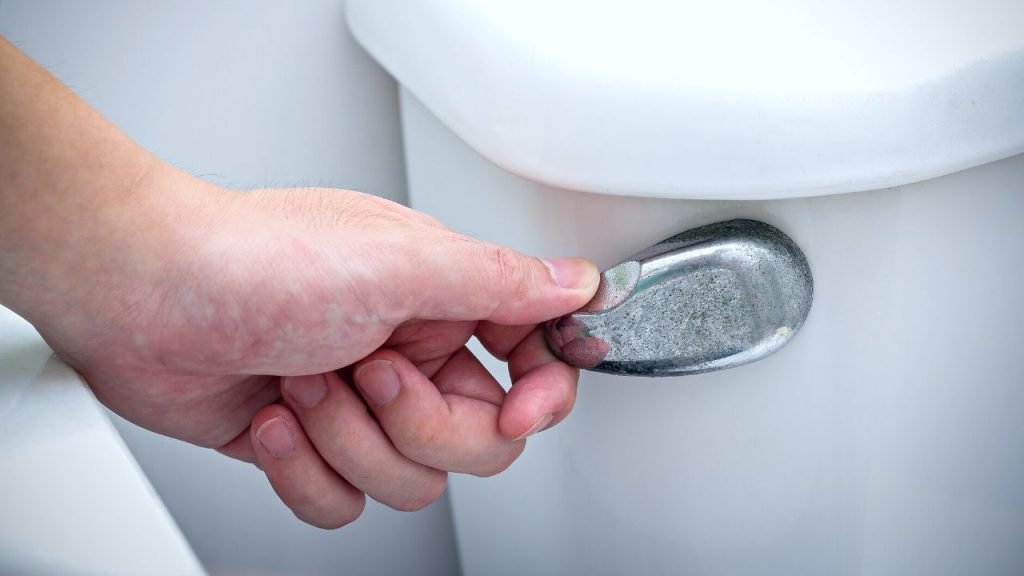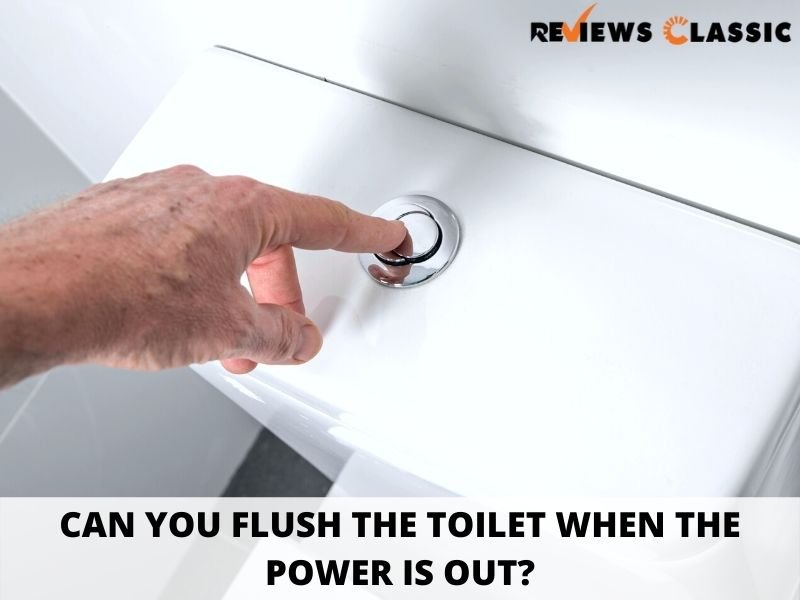Can You Flush the Toilet When the Power is Out? – You Need to Know
Power outage is natural. Also, no matter where you reside, you will almost certainly suffer a power outage at some time. But what if there’s a power outage when you’re on the toilet? So, can you flush a toilet with no power?
The solution is straightforward. It is, however, dependent on the type of toilet flush system you have in your bathroom. In general, there are two types of toilets: those that use electric pumps and those that use gravity to accept water and convey wastewater.
You may be able to flush it multiple times before running out of water, regardless of whether you have power. If your tank has an electric pump, it may cease filling after that. In addition, if you run out of water, you may manually flush most toilets.
So, regardless of the sort of toilet you have, the simple answer is yes for the time being. But let’s dig deeper.
Is it true that Toilets Require Electricity?

The pumping system of a toilet decides whether it needs electricity or not. Basically, Flush Valve Toilets use gravity to do the flushing job, while Pump Toilets require electric energy.
However, the majority of conventional toilets do not need power. The only exceptions are those with a touchpad or that you flush with a wave of your hand. Basically, the upflush toilets. We shall go through them in more detail later in this article.
There is no electricity involved if it is a typical one linked to a municipal sewer system. If the house has a septic tank, toilets in the basement may be below the septic system’s level, necessitating the installation of a separate pump module to carry the waste up to the septic tank.
Furthermore, if the water to the house is supplied by a well pump, there will be no water to flush without power. Municipal water distribution systems that use electric pumps can also go down without power, but they are normally equipped with backup generators.
As you can see, the plumbing system with which you are connected is one of the key contributors to this particular issue.
The Plumbing System

You can receive water from one of two sources: municipal water or private wells/well pumps. Because private wells always employ electric pumps, they do not function after a power outage. Now, what about municipal water? Or more specifically –
If Power goes out, does city water still work?
The answer is Yes! City water is gravity-fed and will continue to flow during a power outage unless you live in a high-rise building or Until something fundamentally disrupts the city’s water pipes (earthquake), you should be able to access water even if the lights are out.
If your home has private well water, it is most likely driven by an electric pump, which implies the toilet will not work without power.
Moreover, in a well pump system, water is pumped from a well into a pressure tank, typically storing 10 to 30 gallons of water.
Basically, water is released from the pressure tank when you turn on the faucet or flush the toilet. When the tank runs low, the pump is activated to replenish it.
In the event of a power loss, you’ll have the same amount of water as you do in your pressure tank. You’ll be out after that, so in this case, you need to use it wisely if you haven’t conserved water ahead of time.
So, in simple words –
With city water/municipal water, power outages wouldn’t be any problem.
With a well pump/private well system, power outages could be a problem.
During a Power Outage, Which Toilets are Unable to Flush?
The answer is Upflush toilets which are powered by electricity. These are frequently placed in basements where the municipal sewer system is above grade, making gravity-fed systems inoperable.
The flushing operation on these toilets is the same; water is released from the tank emptying the waste bowl.
The waste is then sent into a macerator and pump located at the rear of the toilet. Then the macerator turns the waste into a slurry, which is subsequently sent up to the public sewage outfall by the pump.
Waste cannot be transported without the pump, which means you can’t use Upflush toilets without power.
So, based on the above explanation, we may deduce several reasons whether you can or can not flush your toilet when the electricity goes off.
You can flash during the power is out –
Toilet Type: You will need traditional gravity-flush toilets. Basically, they aren’t immediately affected when the power goes out, as long as the water is still running and your waste system isn’t powered by electricity. There’s no reason not to flush as long as the water goes down the toilet and the tank refills.
Water supply system: You need to be connected with the municipal water system of your city if you live in a large community. Municipal water is often supplied by massive holding tanks. As a result, when the power goes out, water pressure and sewage flow to treatment plants are often unaffected.
Moreover, if you get your water from a well that uses holding tanks, it’s still possible to flush during power outages. Although water pressure may be lowered when the well pump and pressure pump lose power, an ordinary tank should still have adequate water for many days of cleansing, depending on how much water you use for other uses.
Do you know, Can You Put Drano Down The Toilet?
You can’t flash during the power is out –
Toilet Type: If you have flush toilets then you can’t possibly use flash during a power outage. As we discussed above, they require power to run macerating blades and a pump that transports waste to the sewer since they are plugged into a wall socket.
If there is no electricity, they will not flush. This sort of toilet is commonly seen in basement bathrooms or other areas of a property that are not linked to the main sewer.
Water Supply System: You have a septic system that employs an effluent pump to transport waste from the tank to a drain field or secondary treatment facility at a higher elevation. With this system when the power is off, the pump will not function. There may still be enough in the septic tank for a few flushes, but flushing too frequently risks overfilling and a severe sewage overflow.
You reside in an apartment complex. During a power outage, you may lose water because the pump that pumps water throughout the facility stops operating. Also, in this case, you will not be able to flush when the power is out.
Now, let’s talk about some solutions.
How do you Flush a Toilet with no Power?

If you have an upflush toilet or one that runs on electricity, it will be difficult to flush when the power goes off. So, what should you do during that situation? Luckily, there is some workaround for this issue. You’ll never be lacking flushing power again if you know it.
Method 1: Backup Water
The first thing is to locate a backup water supply. It might be a stream, water bottles, rainwater from an exterior rain bucket, or pretty much anything else. You’ll need enough of it to fill the toilet tank.
Also, fill the bathtub and as many six-gallon buckets as you can manage as soon as you see or hear the alert for an upcoming outage to prepare for a multi-day power disruption.
Your water storage tank also could be a resource if you have a well. If the water pressure is insufficient to fill the toilet tank, you can drain it using the tank’s faucet or a garden hose.
You can also make a list of places where you can acquire water if the electricity goes out. The trick is to maintain a supply of water on hand at all times, and you’ll be prepared for anything.
Method 2: Generator
Installing a dependable backup generator, often known as a whole-house generator, may guarantee you’re prepared for an electrical power loss regardless of the sort of waste disposal system/flush system you have in your toilet.
A trustworthy generator will keep all of your home’s electrical systems operational, including electrically powered waste collection systems until electricity is restored in your location.
Method 3: Manual operation
This step requires some manual work to initiate your regular flash operation when the power is off. Therefore, in this case, you need to have some knowledge of how your toilet works. But not to worry, we will explain it.
Remove the cover from your toilet and peek inside. Then, by pressing the handle on the flushing lever, a chain connected to the lever lowers the stopper flap on the tank’s bottom.
It will allow the water to flow from the tank into the toilet bowl and eventually flush it. However, there has to be water in the tank for this procedure to begin in the first place.
Method 4: Fill the toilet tank with backup water
After the power goes off, you receive one free flush using the tank that is already full of water. Because there is no water running after that flush, the tank will not refill.
After flushing, pour the additional backup water supply into the toilet tank almost all the way to the overflow tube. When the tank is full, you can flush one more if you need any.
Method 5: Pour water into the toilet bowl
If you pour enough water rapidly enough, the toilet will flush using that approach.
However, if you pour the water slowly or do not use enough water, you will fail, and the bowl will be full of water. Also, you may run the danger of overflowing your toilet. Yuck! Alternatively, you might risk losing part of your saved water.
However, if you don’t have any other choices, this may be your final resort.
Power outage and frozen pipes issue
During a power outage, some water will remain in your pipes. To avoid harm to your pipes, empty them and then reconnect them after electricity is restored.
If you don’t do this, the hose may explode if the water inside expands when it freezes in some cold climates. It is especially concerning in older properties, as their pipes are frequently inadequately insulated.
To avoid this problem, investigate the garage, basement, and outside plumbing for any uninsulated pipelines and cover them in old blankets, towels, or foam.
Conclusion
So, in the end, whether or not your toilet will operate when the power is off is mostly determined by
- How they work and
- The type of plumbing system you are linked to
As we mentioned above, the majority of toilets are not powered by electricity. However, some do, and some connect to water supply or sewer systems that use electric pumps, rendering the toilet inaccessible.
So, regardless of the reason, maintaining a sanitary environment is critical during a power outage. While some outages may be inconvenient for an hour or so, long-term outages necessitate a different approach to keeping things clean and safe for everyone in the home.


